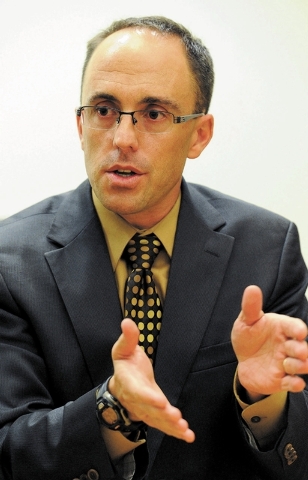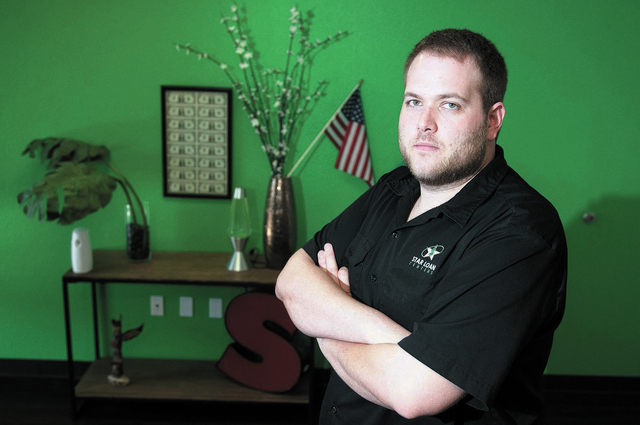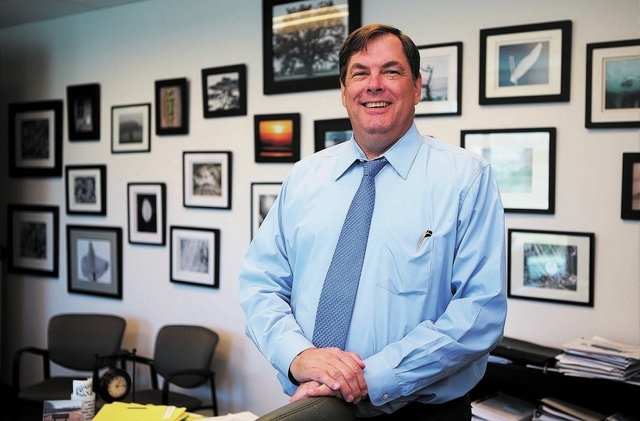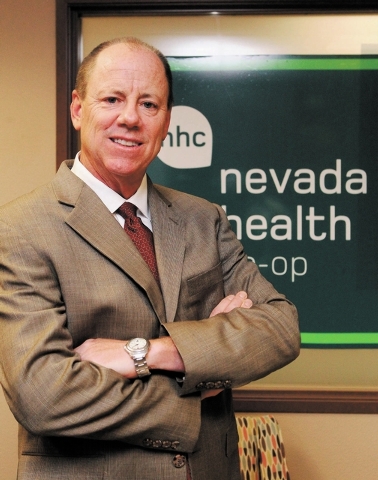Prepare to compare co-pays, costs and carriers















It’s heee-eeere.
After four years of congressional infighting, 2,400 pages of federal legislation, more than 10,000 pages of regulations and three years of statewide planning sessions, the Nevada insurance exchange created under the Affordable Care Act launches on Tuesday.
The Silver State Health Insurance Exchange is far from the first provision of the act, also called Obamacare, to take effect. Already under the law, you can stay on your parents’ plan until you’re 26, insurers must pay you if they spend too much on administration and they have to cover kids with pre-existing conditions.
Still, the start-up of the state insurance exchange is easily the biggest piece yet to fall into place. It’s the core of the law, the public marketplace through which Nevadans will comply with the individual coverage mandate that starts Jan. 1. Hundreds of thousands will buy coverage — or not. Their choice will help determine whether Obamacare works or collapses under its own weight, so you could say there’s a little bit at stake starting this week.
And you could play a role in whether it works out.
HOW WE GOT HERE
Insurance exchanges aren’t new. They have existed pretty much since the advent of the Internet, mostly as places for small businesses to shop for coverage, said Jon Hager, executive director of the Silver State Health Insurance Exchange.
Plans and costs have always varied by market, so a small company with offices in Reno and Las Vegas could pick the best policies in either city, pile costs into one bill and cut a single check to an exchange.
State exchanges were included in Obamacare to bring that streamlined, one-stop shopping to individual consumers who could compare plans side by side. That transparency should encourage more competitive coverage and premiums.
Not every state embraced the concept. Nevada is one of 17 states running its own exchange. Those opting out get a marketplace run by the federal government.
“Whether you opposed the Affordable Care Act or were for it, the feeling was that we should be in charge of our own destiny,” Hager said. “We didn’t want the feds coming in and running it for us.”
Having a state exchange has its advantages, he said. It’s more open: State officials held 61 public meetings from October to March 2011. The exchange board got input from carriers, insurance brokers, consumer advocates and tax professionals, a level of involvement unlikely had the federal government been in charge, Hager said.
Most importantly, Nevada is managing its exchange for less money. Federally run exchanges charge 3.5 percent of premiums for overhead, while the Silver State marketplace will take 3 percent. That’s an estimated savings of up to $3 million a year, Hager said.
“We’re able to do things for a lower cost because we know where to place our ads, and what markets to push our message to,” he said.
That message will have to be comprehensive. Many consumers are still in the dark about exchanges.
HOW IT WORKS
The exchange is open to every Nevadan who is here legally. Are you a sole proprietor looking for affordable coverage? A part-time worker who doesn’t qualify for a plan through your job? A casino worker with a company-sponsored plan who is curious about the cost of individual coverage? A small-business owner who needs a policy for a handful of workers? You can shop the exchange.
More importantly, if you want the federal tax credit for buying coverage, you must go through the exchange.
To start, visit www.nevadahealthlink.com or call 855-768-5465.
Beginning Tuesday, you will submit your information, including your age and number of dependents, and get quotes from four carriers: Anthem, Health Plan of Nevada, Nevada Health CO-OP and Saint Mary’s. You will be able to narrow plans by monthly cost, carrier or provider network. You will be able to compare several plans by deductible, premium and co-pays.
Regardless of the plan you pick, Obamacare requires all insurance coverage after Jan. 1 to come with the same “essential health benefits.”
Plans also must pay for at least 60 percent of the care they cover. No insurer can turn you down because you have a pre-existing condition. And no plan can limit annual payouts for care.
There’s a catch, though. If you want your plan to take effect on Jan. 1, you need to enroll by Dec. 15. In the first year, you can enroll through March 31 to avoid the individual penalty, but after Dec. 15 you will have to wait up to 45 days for coverage to take effect.
In future years, you will be able to buy coverage only between Oct. 15 and Dec. 7, unless you have a qualifying life event such as bringing home a new baby or losing coverage at work. Then, your waiting period could be as much as 60 days.
If all that sounds complicated, the point of the exchange is simple: Make it easier to spread health coverage to the state’s 445,000 uninsured residents, and they will have a primary care doctor to deal with smaller health issues before those problems become full-on medical crises that require pricey hospital care, said Scott Kipper, Nevada’s insurance commissioner. You would want to find emerging diabetes through a routine glucose check, for example, before ending up in the ER in insulin shock.
Shifting care of the uninsured from hospitals to doctors’ offices should save money over the long term, Hager said, although it could be three or four years before we see if the concept cuts costs system-wide. But if the exchange doesn’t start working quickly, it might not make it that long.
WILL IT WORK?
There’s plenty of speculation that the state’s ranks of the uninsured will stay high even after the exchange goes live and the penalty for not having insurance kicks in.
Take the comments of Mike Willden, director of the state Department of Health and Human Services, before the Legislature’s Committee on Health Care in August 2012. Willden noted that Obamacare won’t cover illegal immigrants, and some Nevadans will pay penalties rather than buy coverage. Willden estimated that 10 percent of the state’s population, or roughly 270,000 Nevadans, would stay uninsured post-Obamacare.
Even Hager acknowledges the concept won’t work overnight. The exchange aims for 118,000 enrollees in 2014, 155,000 in 2015 and 169,000 in 2016. Nevada will also expand Medicaid, so that program will cover some uninsured, too.
Frank Nolimal, an employee benefits consultant with Assurance Ltd. in Las Vegas, sees hurdles to reaching expectations. Start with simple manpower. For the exchange to meet its first-year goal, insurers would need to sign up 323 people every day, even on weekends and holidays, a Herculean task for carriers who have slashed administration costs to comply with rules that give you a rebate if they spend too much on overhead.
Then there’s personal responsibility — or lack thereof. Consider Medicaid. It’s free, yet 68,000 eligible Nevadans haven’t signed up, Nolimal said.
So weigh this scenario: You have a 28-year-old, single worker earning $25,000 a year. After tax credits, he could pay a premium of $115 a month for an exchange-based plan with a deductible of $2,500, Nolimal said. Meanwhile, the siren song of consumer goods — smartphones, nightclub cocktails and concert tickets — beckons. And that’s before something serious happens, like an auto transmission failure that costs big bucks to fix.
“You’re going to have a crushing persistency problem. Health insurance is the first thing they’re going to drop, because they’re healthy,” Nolimal said.
Yes, there’s a federal penalty for opting out. But in some cases, the fine is so low it’s toothless. The penalty in 2014 will be $95, or 1 percent of household income, whichever is greater. Take that healthy 28-year-old making $25,000. He will pay a 2014 fine of $250. That’s a much better deal than the $1,380 he would need to pay in post-subsidy premiums. Even in 2016, when his penalty jumps to $695, he still will be fined less than he would pay for a plan.
“I’ll be selling and promoting (the exchange’s) products, and supporting (Hager) as much as possible,” Nolimal said. “But even at lower incomes, people are still responsible for part of their premiums. Even if it’s just $30 to $40 a month, well, they’re not paying anything right now. That leaves me skeptical about how many people will buy.”
Hager is hoping a big advertising blitz will prove Nolimal wrong. The exchange started its radio and print campaign in July, and TV ads on Sept. 15. Billboards and bus wraps will go up Nov. 15. Plus, 220 state and nonprofit employees are training as “navigators” to help people sign up for coverage, and 1,600 insurance brokers say they want to sell plans through the exchange.
Hager estimates the exchange will get 40 percent of its enrollment through navigators, 20 percent through brokers and 40 percent through its call center and website.
“The broker community is really coming together to make this work,” Hager said. “We’re seeing partnerships with community-outreach groups and brokers. We’re also working to make our Web portal seamless so it displays products in ways that make sense.”
Nevada Health CO-OP, a nonprofit insurer that opened in 2012 to sell plans both on- and off-exchange, is already looking for customers. It has a signup kiosk at Meadows Mall, and is scheduling enrollment sessions at local libraries and businesses, said Bobbette Bond, the CO-OP’s chief project officer.
Yet, CO-OP officials have backed off of their initial projection of 30,000 enrollees in the first year, mostly because of consumer confusion about exchanges and the delayed employer coverage mandate.
There is no new forecast, but Bond said the group does expect slow enrollment in the first few months.
“We’re hoping for a good year, but we’re preparing for the alternative,” Bond said.
WHAT IF IT DOESN’T WORK?
If the exchange falls short of projections, that will cause problems.
The network has more than $80 million in federal grants to keep it going through 2014, but after that, it must be self-sustaining, living exclusively on those 3 percent premium charges. Not enough enrollees could mean not enough income to keep things going.
In that case, Hager said, the exchange will do what any business does: “We’d look at what we need to do better, and what we need and don’t need. We’d keep the things that were going well, and fix the things that are broken.”
And if that fails?
“I suppose we could shut down, and the feds could come and run it,” he said. “That’s not a good option, so we’re going to do everything we can to keep it from happening.”
Nolimal agreed that falling back on the federal exchange would be a bad deal for Nevada. A federal system would be especially disastrous for insurance agents, because it has “drastically” reduced compensation for them in some states, offering small, flat fees for each plan they write.
“Agents could not survive in that marketplace,” Nolimal said.
Also unknown is how employers will greet the exchange. They have their own mandate coming on Jan. 1, 2015, when they either must provide company coverage or pay a fine of $2,000 to $3,000 per worker.
Nolimal said he has clients — mostly smaller businesses — who plan to drop insurance because employees will be able to buy on the exchange.
It will be at least a year before it’s clear how that affects exchange enrollment.
Nevada Health CO-OP plans to beef up its off-exchange presence to survive if the marketplace can’t, Bond said. Either way, it will be slow going to make it all work.
“If we cannot get insurance costs to be less expensive than what was previously available overall, then it’s going to fail,” Bond said. “If we can, after a rough start, decrease the cost of coverage and improve care, then we have a chance. It’s just a step-by-step process, and we’re at the very beginning.”
Contact reporter Jennifer Robison at jrobison@reviewjournal.com. Follow @J_Robison1 on Twitter.












